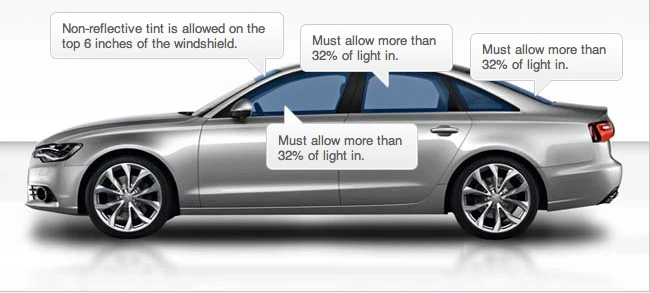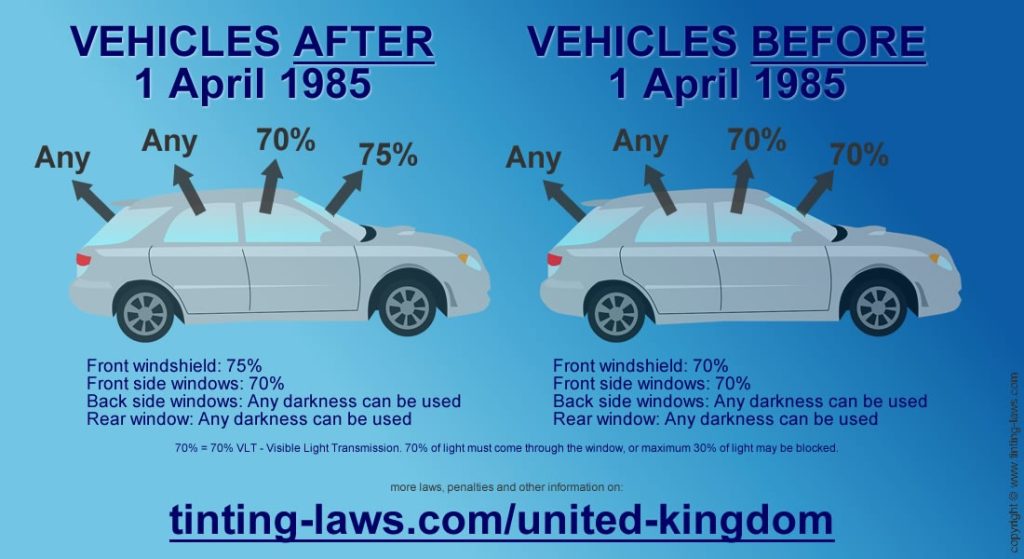As an Amazon Associate, I earn from qualifying purchases
Car tinting laws vary across different regions. Understanding these laws helps avoid fines and legal issues.
Tinted car windows offer privacy and reduce glare. They can also protect you from harmful UV rays. But not all tint levels are legal everywhere. Each state or country has its regulations. Some allow darker tints, while others are stricter.
Knowing the laws in your area is essential before tinting your car. This guide will help you understand car tinting laws and ensure you stay compliant. Learn about the legal limits and avoid potential fines. Your journey to safer, legal tinting starts here.
Introduction To Car Tinting Laws
Car tinting laws vary across different states and countries. Understanding these regulations is crucial for vehicle owners. Tinting your car windows can offer many benefits. But it is important to ensure compliance with local laws. Failure to do so can result in fines or other legal penalties.
Importance Of Car Tinting
Car tinting offers several advantages:
- Privacy: Tinting provides more privacy for passengers.
- UV Protection: It blocks harmful UV rays, protecting your skin and car interior.
- Temperature Control: Tinted windows help keep your car cooler.
- Glare Reduction: Tinting reduces glare from the sun and oncoming headlights.
Legal Implications
Each region has specific laws about the level of tint allowed. These laws ensure that drivers have adequate visibility. Excessive tint can obstruct the driver’s view, leading to accidents. Below is a table summarizing the legal tint limits in some regions:
| Region | Front Windows | Rear Windows |
|---|---|---|
| California | 70% light transmission | Any |
| Florida | 28% light transmission | 15% light transmission |
| Texas | 25% light transmission | Any |
Non-compliance with these laws can lead to:
- Fines and penalties.
- Vehicle inspection failures.
- Increased insurance premiums.
Stay informed about your region’s tinting laws to avoid these issues.
Current Regulations
Car tinting laws vary significantly across different regions. Understanding these laws is crucial for car owners to avoid fines and penalties. The current regulations encompass both state-specific laws and federal guidelines. This section will delve into these aspects to ensure you remain compliant.
State-specific Laws
Each state in the U.S. has its own set of rules regarding car tinting. These laws dictate the permissible levels of tint darkness and reflectivity. The table below highlights some key differences:
| State | Front Side Windows | Back Side Windows | Rear Window |
|---|---|---|---|
| California | 70% VLT | Any | Any |
| Texas | 25% VLT | 25% VLT | 25% VLT |
| Florida | 28% VLT | 15% VLT | 15% VLT |
In the table above, VLT stands for Visible Light Transmission. A higher VLT percentage means more light passes through the window. Always check your state’s specific regulations before applying car tint.
Federal Guidelines
The federal government also imposes some regulations on car tinting. These guidelines ensure safety and uniformity across the nation. Here are some key points:
- Tint on windshields must allow more than 70% of light in.
- Reflective tint should not exceed 20% reflectivity.
- Mirrored or metallic tints are generally discouraged.
Adhering to federal guidelines not only keeps you legal but also ensures your car remains safe for driving. Understanding both state-specific laws and federal guidelines will help you make informed decisions about car tinting.
Changes In 2025
The car tinting laws are changing in 2025. These changes aim to improve safety and visibility on the road. Understanding these changes is crucial for car owners.
New Restrictions
In 2025, new restrictions on car tinting will be enforced. These rules will limit the darkness of tints on car windows. Front windows will have stricter guidelines. This ensures drivers can see clearly and avoid accidents. Rear windows will also face new limits. These changes aim to reduce illegal activities.
Updated Permissions
Along with restrictions, some permissions will be updated. Certain vehicles will have special allowances. Emergency vehicles can have darker tints. This helps protect the privacy of those inside. Medical exemptions will also be considered. Those with specific conditions can apply for permits. These updates balance safety and personal needs.
How Tint Darkness Is Measured
Understanding car tinting laws can be complex. One important aspect is how tint darkness is measured. This ensures compliance with legal standards and maintains road safety. Let’s dive into the details.
Visible Light Transmission (VLT)
Visible Light Transmission, or VLT, indicates the amount of light that passes through the window film. It’s measured in percentage. A higher VLT means more light passes through. For example, a 70% VLT allows 70% of light to pass through. Lower VLT means a darker tint. Different states have different VLT requirements. Knowing your state’s laws is crucial.
Tools For Measurement
Special tools are used to measure VLT. A tint meter is the most common tool. It’s placed on the window and measures the light passing through. Another tool is a spectrophotometer. This device provides a detailed light transmission analysis. Accuracy is key for these tools. Regular calibration ensures correct readings. Using these tools helps car owners stay compliant with tint laws.
Exemptions And Special Cases
Car tinting laws can be strict. But there are some exemptions and special cases. These allow certain people or vehicles to have different tinting rules. Let’s explore some of these exceptions.
Medical Exemptions
Some people have medical conditions that make them sensitive to sunlight. For them, darker tints can be a necessity, not a luxury. States often allow medical exemptions for car tinting. These exemptions require a doctor’s note. The note must explain the medical condition and why darker tints are needed.
Here is a list of common conditions that may qualify for an exemption:
- Lupus
- Albinism
- Skin cancer
- Photosensitivity
Each state has its process for applying for a medical exemption. It’s important to check your local laws.
Commercial Vehicle Rules
Commercial vehicles have different tinting laws from private cars. These rules focus on safety and visibility. For example, delivery trucks often need clear windows to ensure safe driving. But some commercial vehicles, like limousines, may have more lenient rules. This is to provide privacy for passengers.
Below is a table summarizing the tinting rules for some common commercial vehicles:
| Vehicle Type | Allowed Tint Level |
|---|---|
| Delivery Trucks | Minimal Tint |
| Limousines | Darker Tint |
| Public Buses | Clear Windows |
Check with your local Department of Transportation for specific rules. Always ensure your vehicle complies with the law.

Credit: thetintguy.com
Penalties For Non-compliance
Car tinting laws exist to ensure safety on the road. Following these laws is important. Violating them can lead to serious consequences. Non-compliance with these laws attracts penalties. These penalties can affect your finances and your insurance.
Fines And Tickets
Breaking car tinting laws can result in fines. The amount of the fine varies by state. Some states charge more than others. Tickets may also be issued. Repeat offenders might face higher fines. Paying these fines on time is crucial. Unpaid fines can lead to more penalties.
Impact On Insurance
Non-compliance can affect your car insurance. Insurance companies view lawbreakers as high-risk drivers. This can lead to higher premiums. Your insurance policy might get canceled. This affects your ability to drive legally. Always follow the laws to avoid such issues.
Tips For Legal Tinting
Car tinting laws differ from state to state. To stay within the law, car owners must know these regulations. Here are some tips for legal tinting.
Choosing The Right Tint
Choosing the right tint is crucial. Check the Visible Light Transmission (VLT) percentage allowed in your state. Some states have strict laws on how dark your tints can be. Using a tint with the correct VLT will ensure your car is street-legal.
Consider the type of tint film. Dyed tints are less expensive but may fade over time. Ceramic tints cost more but last longer and offer better UV protection. Choose one that fits your budget and needs.
Professional Installation
Professional installation is key to ensuring your tint meets legal standards. A professional installer knows the laws and can help you choose the right tint. They use precision tools to apply the tint evenly. This prevents bubbles and ensures a smooth finish.
A professional job looks better and lasts longer. Poorly installed tints can peel or bubble, which may lead to fines. Spending a bit more on professional installation can save you money in the long run.

Credit: www.tinting-laws.com
Future Trends In Car Tinting
Car tinting is changing fast. New technology and laws are shaping its future. The trends to watch are exciting. They promise better and safer car tinting options.
Technological Advancements
Technology is driving changes in car tinting. New materials are being developed. These materials improve heat reduction and UV protection. For example, nanoceramic films are becoming popular. They offer superior performance without affecting visibility.
Smart tinting is another trend. It allows drivers to adjust the tint level. This can be done with a button. Smart tinting uses electrochromic technology. It changes the film’s color in response to an electric signal. This helps in different lighting conditions.
Additionally, manufacturers are working on films that can block harmful rays. These films protect car interiors and reduce glare. They also enhance privacy for drivers and passengers.
Evolving Legal Landscape
The legal landscape for car tinting is changing. Different regions have different laws. These laws regulate the darkness and reflectivity of tints. Authorities update these laws to ensure road safety and visibility.
Some regions are relaxing their tinting rules. They are allowing darker tints for better heat reduction. Other areas are becoming stricter. They aim to improve safety by limiting how dark a tint can be. It’s important for car owners to stay updated on these changes.
States are also considering new standards for tinting materials. These standards ensure that films are effective and safe. Car tinting businesses must comply with these regulations. It helps them avoid fines and legal issues.
Overall, the future of car tinting looks bright. With new technologies and evolving laws, car owners will have better options. These trends will make driving safer and more comfortable.

Credit: www.cartintlaw.com
Frequently Asked Questions
What Are Car Tinting Laws?
Car tinting laws regulate the darkness and reflectiveness of car windows. They vary by state or country. Always check local regulations before tinting.
How Dark Can I Tint My Windows?
Each state or country has specific limits on window tint darkness. Typically, the front windows must allow more light than the rear.
Are There Exemptions To Car Tinting Laws?
Yes, some jurisdictions offer medical exemptions for specific conditions. You may need a doctor’s note and official documentation.
What Are The Penalties For Illegal Tint?
Penalties can include fines, mandatory removal of tint, or even vehicle impoundment. Check local laws to avoid these consequences.
Conclusion
Understanding car tinting laws is crucial for every driver. These laws keep everyone safe. They also ensure fair visibility on the road. Always check your local regulations before tinting your windows. Staying informed helps avoid fines and legal issues. Remember, safety and legality go hand in hand.
Drive smart, drive safe with proper tinting.
As an Amazon Associate, I earn from qualifying purchases


